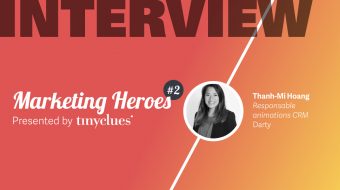Based in the Netherlands, Crystalloids is a Google Cloud Partner specializing in marketing analytics and in building headless customer data platforms (CDPs). Long-time partner of Tinyclues, we have asked Jan Hendrik Fleury, Crystalloids CCO, to chat with us about first-party data, privacy, and, of course, CDPs.
Hello Jan Hendrik! In a few words, would you introduce yourself and tell us what you do?
Sure! I’m Commercial Director at Crystalloids. Additionally, I’m a chairman at the Data-Driven Marketing Association in the Netherlands.
Crystalloids is a boutique data engineering and data science company specializing in unified analytics and activation platforms for both enterprise data and customer data. We build customer data platforms, commonly referred to as CDPs.
The Data-Driven Marketing Association is a marketing association that now has 381 paying members from large banks and NGOs to tech companies and retailers. We develop a lot of content for data-driven marketing in general: CRM, CRO, CDPs, measurement, anything as long as it is data-driven marketing. We also employ legal counsels, and we help companies, advising them when it comes to Privacy and Security legislation compliance. We are also involved in the design of legislation when it comes to data privacy, both with the local privacy authority and on a European level. For instance, if there are any plans in the works, we look into these plans: what will happen to the consumer experiences and trust, to the suppliers of the industry, and, of course, the advertisers, too. We look at data privacy in a holistic way, to help authorities make the best decisions.
You’ve been writing and presenting a lot on CDPs. Could you please explain to our readers the different types of CDPs – pure player, hybrid, built-in – and share the benefits you see?
It’s difficult to define what a CDP is because everybody has his own definition of what a CDP is. I don’t see a CDP as one tool.
To me, a CDP is a combination of capabilities and technologies that allow for interaction with B2B or B2C customers in the most effective ways possible, and with measurable results
CDPs are a combination of many things and usually encompass all of the following functions, in order:
- Ingestion of data, i.e., creating a landing zone for data streams and batch data
- In most cases, transforming the data so that the data can be used by systems and persons in a common way
- Data storage in a so-called data lakehouse
- Analytics applied on a centralized view of the customer
- Identity resolution, where all information about a specific customer is matched to make sure there are no duplicates, and where business identities can be linked as well
- Activation of customers, serving them with the right message at the right moment
- And to finish: Overall governance of the platform and the KPI metrics
That’s what CDPs are for. I would say that it’s a combination of certain functions and specific pieces of technology that together form a CDP.
What are the three main types of CDPs?
There are centralized suites like Adobe or Salesforce. And there are packaged CDPs, most of them offering one or two capabilities you need in a unified marketing stack. They sometimes claim they can offer everything but that is not true and might not even be desirable. Then there’s the modular stack, where you integrate packaged SaaS point solutions and other systems such as SAP in a public cloud platform; that’s a combination of packaged and code-based. Two examples of data-consumers are Hightouch or Tinyclues – these solutions are fed with centralized, normalized,checked data in order to perform well, and are useful for audiences with user interfaces designed for those who can’t code or just use SQL.
Then there’s the fully do-it-yourself CDP. This type of CDP is for the very technical, tech-savvy companies. These companies build almost everything in a cloud-native way in one or two public clouds.
With a modular CDP, you will still have to do most of the plugging and integration yourself, am I right? You can’t just plug different solutions together and expect them to work.
You’re right. If you have a composable CDP where the heart is in the public cloud, you could divide it into many different public cloud products for collection, transformation, storage, and governance to be privacy and security compliant. These products, such as Big Query and Google Cloud Dataflow, are accessible via a console, a ‘window for engineers.’ These products are natively integrated with all the tools and processes you need to build and integrate software. If you don’t have these architecting and engineering skills, you can hire a service partner like Crystalloids. And we will teach you how to do it yourself along the way if you want.
To make sure I understand correctly: You do the collection, the storage on GCP, and then integrate the different SaaS solutions on top of that?
Yes, sort of. I would rather place the modules on both the data delivery and data consumer side of the platform. All systems provide data and need other data as well.
What kinds of solutions will be in the composable data stack?
In the modern data stack, you can use all sorts of SaaS solutions, on what is historically called the IT side, but also on the analytics side, and the activation. That type of stack is growing.The central part is an analytical data store like Snowflake, Redshift, or BigQuery. There are many options – it’s kind of confusing if this is not your daily business.
I think that if you use too many tools, then you have integration problems, contracting problems. You really need to be knowledgeable about data and integrations and IT. Integration is not that easy. It never is.
I suppose you’ve helped quite a lot of clients move from a classic stack to these modern stacks. What is their main reaction after realizing that something else is possible?
Until now, the reactions have always been positive because clients had various reasons to change. Either they were uncertain of what they wanted, or they weren’t aware of the possibilities of changing their stack, of what it would bring to them -or instance, the ability to focus on first-party data rather than third party cookies.
The way we build CDPs is either fully do-it-yourself or the composable CDP. CDPs primarily provide centralization, flexibility, and modularity. By centralization, I mean the centralization of data, of analytics, of content, of campaign management, and the governance over the total stack, the data flows, the data quality… In most cases, we build a headless CDP – that means a CDP with centralization and API integrations. Headless CDPs offer a lot of flexibility;customers really appreciate that flexibility, and the governance over the total solution. And like with SaaS, no technical maintenance is required if we develop ‘serverless.’
And next to that, what I like is that there’s, in most cases, a significant cost reduction involved. If you centralize most of your data in public clouds, you could save a lot, provided you implement your CDP well.
With centralized data, you get much more value out of solutions like Tinyclues. They perform much better because the more data sources are connected, the better the data quality that goes into Tinyclues, and the better the modeling will be! In some cases, a company can have twelve relevant data sources that can be fed into Tinyclues. But they use only six or seven. When companies start building a centralized data architecture integrating all the relevant data sources, tools like Tinyclues bring even more value, improving companies’ CRM performance.
First-party data are trending these days, especially with the disappearance of third-party cookies. How do you think this trend will impact companies and the customer experience?
What I like about this development is that companies now really have to do their best to get customer consent in order to use their first-party data. Sometimes this can be forgotten. There needs to be a good value exchange between what the customer will be delivering by consenting to the use of their PII and what the company will give the customer in return. If a customer doesn’t trust a company, or if the value exchange is not clear, why would anyone give consent, just to potentially receive maybe 5 or 6 spam emails? On the other hand, if a company is clearly explaining to a customer that they will get a discount and early access upon registration, they have much more propensity to give consent.
That’s very important. Indeed, if very few customers give consent, then personalization strategies will become irrelevant, or the benefits of solutions like Tinyclues will be reduced.
Talking to clients, I can feel the change in governance that the CDP is bringing about. But I feel there’s also a change in terms of internal dynamics: companies have been spending a lot on acquisition and now, with the disappearance of third-party cookies, I feel that analytics are becoming very important. There are a lot of questions around attribution, and a growing sense of, ‘I can’t just spend money on Criteo or Google Ads and repurchase my clients over and over again.’ Maybe budget would be better allocated elsewhere. Acquisition teams need to be more and more careful.
I feel the same way. They indeed need to be more careful. And of course a complication is that the overall measurement of the performance of paid advertising becomes more difficult because there’s less visibility into the data. Acquisition teams have to model the conversions to the total audience and as a result, it’s becoming less reliable. When it comes to measurement, companies will be a bit more in the dark.
You can see that companies like Criteo are now investing more and more in CRM and trying to have the CDP data, in order to improve their algorithms. Everybody is on the same train.
That’s the only way for them to go. What we see with all clients is, of course, the focus on first-party data, but also the ability to execute. Once we have managed to centralize the data, the decisioning, we have precise audiences and propensity scores, companies might still have an issue executing on all the identified segments. How do you operationalize the content, or your team, to orchestrate and make campaigns happen?
The technology is a prerequisite and even when the technology is in place, companies aren’t there yet [in terms of operationalizing]. Tinyclues, with its simple UI, is really helping, but there needs to be more. Companies also need the right images for their communications. It’s working on two fronts: organizational and technological.
That’s what we always check when we are designing a solution. We take into account how mature a client is and their ability to execute.
We’ve been hearing a lot about AI solutions plugged on top of CDPs. Do you feel this is trending amongst your clients? Do you have any client success stories to share?
Yes, it definitely is becoming trendy. At Crystalloids, we don’t have thousands of clients. What I see is just a small part of the market. Many companies, as we already discussed, don’t have a centralized view on their data yet. These companies, then, don’t have the maturity to apply AI to their data stacks. Doing so represents a certain level of maturity.. A good point about the current focus on CDPs is that it is now starting to feel safe to integrate an AI modeling strategy. It’s just the beginning if you ask me.
If you were completely free to build the best CRM practices from scratch for your clients, what would you do?
I guess that depends on the situation. It depends on how big a company is, how many customers and prospects a company has, how complex the organization is. Do they have many units? How international is the company? In international companies, there’s different identity management, local privacy legislation. How technical are these companies? How much budget do they have?
What I like about our business is that there is no single way to go when it comes to CDPs or to campaign management. We always have to look at the situation of a client holistically, only then can we advise on the best CRM solution for their situation.
That might not be the dream answer to your question, but I simply can’t answer [in one way]. There’s no one-size-fits-all answer.
Of course, in a dream world, all my clients would have a lot of complex data, perfectly centralized, so that CRM solutions have the maximum effect, acting as fuel for [solutions like] Tinyclues. We’re working on that!




